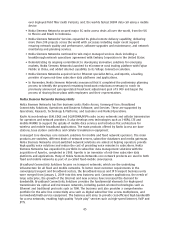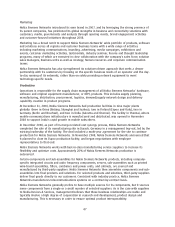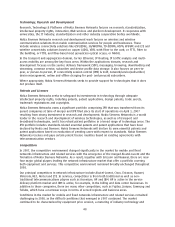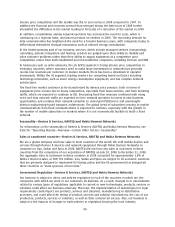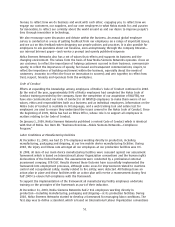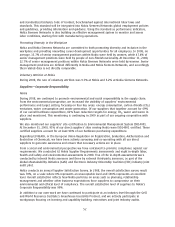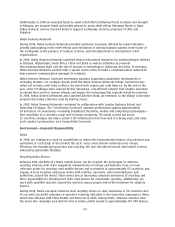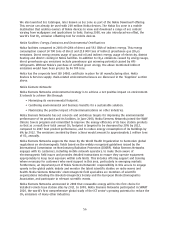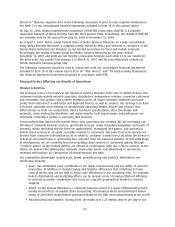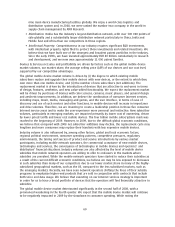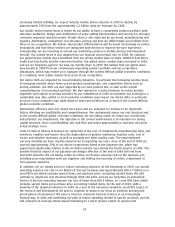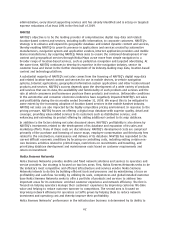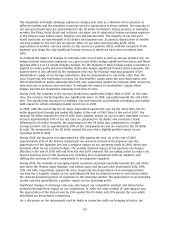Nokia 2008 Annual Report Download - page 56
Download and view the complete annual report
Please find page 56 of the 2008 Nokia annual report below. You can navigate through the pages in the report by either clicking on the pages listed below, or by using the keyword search tool below to find specific information within the annual report.In 2008, Nokia continued to participate in financing the collection and treatment of electronic waste
in different EU countries in accordance with requirements as set by National Implementation of the
European Union WEEE directive, or directive on Waste Electrical and Electronic Equipment. There are
now national collection networks in operation to collect and treat all electronic waste from
households. During 2008, the EU Directive 2006/66/EC on Batteries initiated national setup of similar
collection networks for portable batteries. In addition, Nokia has during 2008 increased
communication on recycling on local country level with the introduction of localized recycling
information on Nokia Internet pages.
Energy Saving in Nokia Devices
Over the last decade, we have reduced the average noload energy consumption of our chargers by
over 80%, and our bestinclass chargers by over 95%. We are making good progress in reaching the
target of reducing noload power used by our chargers by 50% from the 2006 level by the end of
2010.
Nokia was the first mobile manufacturer to put alerts into devices encouraging people to unplug their
chargers, and we are rolling these alerts out across our device range. Based on a voluntary
agreement, namely EU IPP, or the EU pilot project on Integrated Product Policy, Nokia together with
other manufacturers created and took into use a Mobile Device Charger Energy rating. The 05 star
rating is based on the charger’s noload power consumption and is shown as a specific label that
raises awareness and encourages the use of more energyefficient chargers. All new Nokia chargers
are specified to meet the criteria of voluntary agreements such as the EU Code of Conduct and US
Environmental Protection Agency’s Energy Star and the highest four and five star criteria of EU IPP.
Materials in Nokia Devices and Packaging
All Nokia mobile devices worldwide are fully compliant with EU RoHS, or the EU directive on the
restriction of the use of certain hazardous substances in electrical and electronic equipment. We have
also phased out PVC from all Nokia’s mobile devices and enhancements. We are currently phasing out
the use of brominated and chlorinated flame retardants and Antimony Trioxide. The first device
leading this phaseout, the Nokia 7100 Supernova, was launched in November 2008.
In early 2008, we started shipping Nokia 3110 Evolve, the first mobile device whose biocovers use
50% renewable materials, thus reducing the amount of fossil fuels used to manufacture it. Nokia’s
high efficiency charger AC8 was launched with the Nokia 3110 Evolve, and is now shipping in
volumes with many of our devices. The packaging for the Nokia 3110 Evolve contained 60% recycled
materials, doubling the amount of recycled content typically used. Furthermore, due to the smaller
size of the overall sales package, substantially less cardboard is used.
We continue to improve our packaging solutions. The use of renewable, paperbased materials has
been increased to over 95% of total packaging materials. From August 2008, the sales packages of all
new devices have been smaller than their earlier equivalents. From February 2006 to the end of 2008
we reduced the weight of packaging materials and user guides of our most affordable devices by
over 60%, which amounts to some 100 000 tons of saved paper. Smaller and lighter packaging has
also reduced the need for transportation. The improvements in our packaging solutions have also
translated into significant monetary savings.
Promoting Sustainability through Nokia Services and Software
Eco services have been developed to help people to make sustainable choices and to consider
environment in everyday life. A variety of eco services are freely downloadable in Nokia devices.
In December 2008, we introduced the betaversion of Green Explorer, a free service designed to
promote sustainable travel. The service is a combination of travel guide information and tips about
sustainable travel shared by the users themselves.
55


